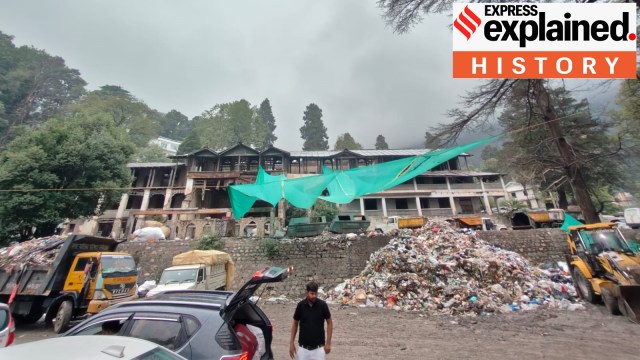Last week, the Ministry of Home Affairs temporarily allotted Nainital’s Metropole Hotel Complex — classified as enemy property — to the state government for use as a parking facility. Chief Minister Pushkar Singh Dhami had requested the allotment in light of the serious parking issues in the popular hill station.
Built in 1880, Metropole was owned by the Raja of Mahmudabad and is one of the oldest luxury hotels in Nainital. This is where Mohammad Ali Jinnah and his wife Rattanbai honeymooned in 1918. The design of its roof came to be known as Nainital-pattern-roofing, which the British then used in many buildings across India.

However, the hotel was later classified as enemy property, setting in motion its slow decline.
Metropole Hotel, the Enemy Property
After Mohammad Amir Ahmed Khan, the Raja of Mahmudabad, moved to Pakistan post Partition, his considerable properties in north India, including the 11-acre Nainital hotel, were declared enemy property.
His son and heir Mohammad Amir Khan, who remained in India, fought a 30-year-long legal battle for the properties, and eventually secured a favourable Supreme Court order in 2005. However, his win opened the floodgates for similar litigation across the country, with genuine or purported relatives of people who had migrated to Pakistan producing deeds of gift claiming they were the rightful owners of enemy properties.
On July 2, 2010, the UPA government promulgated an ordinance that restrained courts from ordering the government to divest enemy properties from the Custodian. The 2005 SC order was thus rendered ineffective.
Hosting history
Metropole, says historian and former professor Dr Ajay Rawat, was frequented by tall figures of history. “Pandit Rahul Sanskrityayan, who was an exceptional scholar with proficiency in almost 11 languages, stayed there and wrote his famous work, Kumaun. Historian Dr Satyaketu Vidyalankar briefly maintained it,” he said.
Story continues below this ad
Speaking of his time in the hotel when he was eight years old, historian and former JNU professor Pushpesh Pant said that in 1953, the hotel was managed by a Parsi man, Shapoorji. “I still remember the luxury we had in Metropole. It was an extension of your home. We had our meals in the suite we were occupying, and it was brilliant. It had four tennis courts, a billiards room, and a reading room. I was too young to realise that the hotel was already starting to show signs of wear and tear,” he said.
The next time he visited Nainital, in 1960, the hotel’s fortunes were dipping. People had started encroaching on the grounds of the property.
“When Nainital became a destination for films, several actors would stay at the Metropole. Actors Shashi Kapoor, Dev Anand, and their crew have stayed there. The cast of films like Gumrah also stayed there. Till the mid-60s, the hotel was catering to guests. After this, the perception of ‘enemy property’ made people wary of investing in its maintenance,” Pant says.
Another reason for its fall is the change in the tourists themselves, Pant believes. “After the departure of the Europeans, no one would pay to stay in a hotel to play billiards or go to a bar. They would rather go out. Soon, the hotel’s sprawling grounds began to be used as a parking space. This is the connecting link to the present developments,” he says.
Story continues below this ad
Pant also said that after the 2010 ordinance, the government could have taken up the hotel as a heritage building. “The saddest part is that the bureaucracy wants to demolish heritage buildings and give contracts to somebody. Before this, Post Office Tallital was to be demolished to widen a road.”
In her book Mr and Mrs Jinnah, Sheela Reddy hints at the time the couple stayed in Nainital. “As on this first evening of her honeymoon, coming down to dinner with the Raja of Mahmudabad’s family in his palatial residence in Lucknow. She was dressed unexceptionally—underdressed, in fact, for a newly-wed—in a plain white sari with a black and gold embroidered border, and with no trace of the shy, demure bride. Jinnah had accepted Mahmudabad’s invitation to visit them in Lucknow before driving to Nainital, where they would stay for a month in the Raja’s house in the hill station,” she writes of Rattanbai, also known as Ruttie.
Legal battles
In 2023, the SDM of Nainital served notices to people living near the hotel, calling them encroachers on enemy property. The residents moved the High Court, claiming they had been living in the property’s outhouses since the time of their forefathers.
However, the court held that the property is required for developing a parking lot, “which is a crying need for the town of Nainital”.
The future plan
Story continues below this ad
According to the Nainital administration, the parking lot will have a surface parking facility to accommodate 510 cars and 200 two-wheelers. “A DPR has been prepared, estimating the value of the project to be Rs 43.83 crore. However, a matter to be noted is that the parking lot will not function at 100 per cent potential because Nainital sees tourists for six months,” said an official.
He further said that the property is not a heritage property, and no demand has been raised to categorise it as such. “The accommodation of historical figures alone cannot fulfil heritage norms. This move will help reduce the congestion in the city and ensure the lives of locals are not disrupted. The hotel is a dilapidated structure and was a garbage dumping ground,” he added.







































